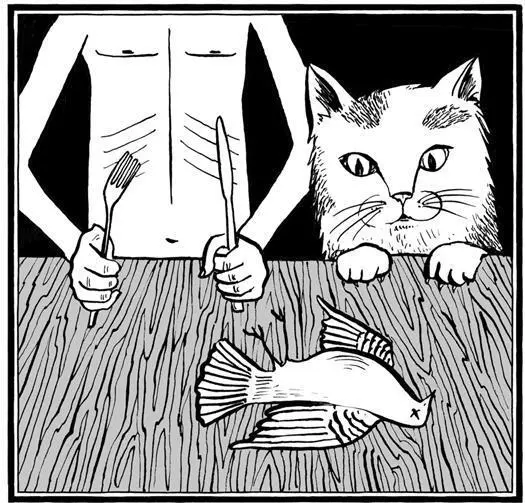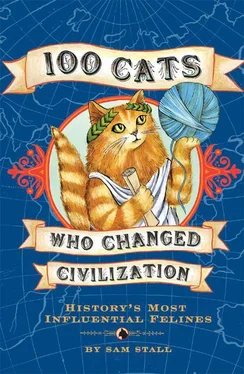Today, the Church of St Mary the Virgin and All Saints in Maidstone features a stone memorial to Wyatt, “who was imprisoned and tortured in the Tower, in the reign of King Richard the third, kept in the dungeon, where fed and preserved by a cat.” The monument is a touchstone of sorts for the extended Wyatt family, which thrives in both the United States and Canada—and would be all but extinct were it not for one resourceful feline.

MANEKI NEKO
THE FORLORN TEMPLE CAT WHO BECAME JAPAN’S SYMBOL OF GOOD FORTUNE

A visitor to almost any Japanese shop, restaurant, or bar will likely find, crouched near the entrance, a small porcelain statue of a cat. The cartoon-like creature may sport a slight smile and hold a gold coin cupped in one paw. The other paw (either the right or left) will be raised in a beckoning gesture. This is the famous Maneki Neko, or beckoning cat, a charm that supposedly attracts wealth and good fortune to anyone who displays it. But this creature may not be entirely mythological. According to Japanese legend, it is based on a real tortoiseshell tabby—a tabby whose timely invitation to a passing nobleman elevated a humble Buddhist shrine to wealth and fame.
Several different stories purport to tell what happened, but the following is the most commonly recounted: Sometime during Japan’s Edo period (1603–1867), a nobleman rode past a rundown temple outside Tokyo. While passing, he happened to notice the temple master’s cat, which seemed to beckon to him. Intrigued and perhaps slightly unnerved, he dismounted and approached. At that moment a lightning bolt struck the spot on the road he’d just left.
The noble, who believed the humble feline kept him from destruction, endowed his temple home with lands and money. Years later, when the cat who saved his life died, he had the first Maneki Neko figurine created in his honor. According to some versions of the tale, the place in question was the famous Gotoku-ji shrine near Tokyo. Whether this story is true is anyone’s guess. However, the popularity of cat statues among the Japanese is indisputable. They have been produced by the millions, in versions ranging from piggy banks to dashboard ornaments—all of them designed to attract money and luck to their owners, just as the original feline did.
The wings of pop culture have spread the talisman’s influence around the world—sometimes in unexpected ways. One of the most famous Pokémon characters, Meowth, is an anime incarnation of Maneki Neko. And the ubiquitous Hello Kitty bears more than a passing resemblance to the famous feline. Even her name is considered by some to be a loose translation of that of the beckoning cat.

RUTTERKIN
THE CAT WHO WAS ACCUSED OF MURDER

During the Middle Ages, European cats received some of the worst press in the history of the species. They were accused of being agents of evil and of serving as familiars for witches. Popes occasionally railed against them, and public disapproval of felines could grow so heated that they would be exterminated from entire towns.
One example of this overreaction took place in Lincoln, England, in 1618. Joan Flower and her daughters, Margaret and Philippa Flower, were accused by the local magistrates of using the dark arts to take revenge on their employers, the Earl and Countess of Rutland. History doesn’t record the reasons for their ire. However, it describes their alleged methods in forensic detail. According to testimony from the women (extracted, as was usual at that time, under torture and intense interrogation), Joan Flower possessed a spirit familiar called Rutterkin, which manifested itself in the form of a sinister-looking black cat. The feline was their weapon of choice when casting spells. One favorite tactic was to steal gloves from members of the Earl’s family, boil them, prick them full of holes, and then rub them along Rutterkin’s back. According to court proceedings, this odd-sounding bewitchment accomplished the death of the Earl of Rutland’s son, Lord Ross.
And what did the supposedly demonic cat get in exchange? In addition to the women’s immortal souls, he also was allowed to feed on Joan Flower’s blood.
The death of Lord Ross, plus various odd illnesses suffered by other close relations, finally drove the Earl of Rutland’s family to believe that the Flowers were hatching some sort of plot against them. The women, after enduring all the usual inducements available to the medieval legal system, signed confessions. Joan died in custody, but her daughters were burned at the stake.
What became of Rutterkin? One hopes he had the good sense to simply slink away. His kind were maligned throughout Christendom, making it impossible for the hapless feline to get a fair hearing. Even today, in our supposedly enlightened era, his descendants are slandered in everything from Halloween cards to cheap, straight-to-video horror flicks. In a very real sense, today’s black cats have one paw in the Dark Ages.
SINH
THE LEGENDARY CAT WHO WAS THE FIRST BIRMAN

Few cat breeds have histories as colorful—or as steeped in violence—as the Birman. This elegant, distinctive-looking longhaired cat owes its existence to two redoubtable felines, one of them legendary, the other quite real.
The first, called Sinh, was supposedly one of a hundred snow-white, yellow-eyed cats inhabiting the Temple of Lao-Tsun in Burma. There the golden, blue-eyed, female goddess, who oversaw the transmutation of souls from one plane of existence to the next, was worshipped by the Khmer people of Southeast Asia. Sinh was a particular favorite of the shrine’s chief monk, Mun-Ha.
One night raiders attacked the temple, mortally wounding Mun-Ha. As the monk lay dying, Sinh planted his feet on his master’s chest and faced the golden statue of the goddess. Suddenly his white body turned to gold and his yellow eyes to sapphire blue. His legs turned brown like the earth, but his feet, where they touched the priest’s body, became snow white as a symbol of purity. Not long afterward, all the other temple cats were similarly transformed.
Sinh, who had also taken up the soul of Mun-Ha, remained standing in front of the statue of Lao-Tsun, his eyes locked on hers. He died after seven days, delivering the spirit of his master to heaven. Afterward, it was said that whenever a Birman temple cat expired, the soul of a dead priest accompanied it to paradise.
Ironically, a tragedy not unlike the one that inspired the story of Sinh was instrumental in bringing this exotic breed to the West. In the early years of the twentieth century, the ancient temple was once more attacked by raiders. This time, however, two outsiders, Englishmen Major Gordon Russell and his friend Auguste Pavie were on hand to assist the monks in repelling the assault. Years later, in 1919, the monks sent Pavie, who had relocated to Europe, a reward—a male and female Birman. The male died during the long sea voyage to his new home, but the female arrived safely, and she was pregnant. It is generally believed that this single feline and her kittens formed the root stock of the Western branch of the Birman family.
Читать дальше















